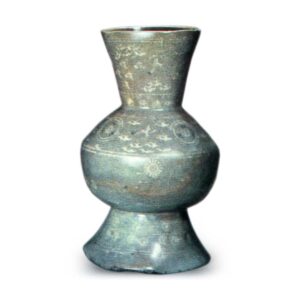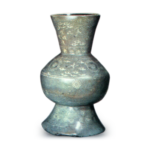
This inlaid celadon ware is from the latter half of the Goryeo celadon period and is mainly decorated with flying cloud and dancing cranes, but also includes other similar wares. It dates from the late 12th to early 14th centuries, from the reign of King Yijong of the Goryeo Dynasty to that of King Chung-Yeol of the Goryeo Dynasty, and was later passed down to the Mishima group and then to the Yi Dynasty. Yi Jong’s extravagant tastes led to a demand for celadon tiles and other wares, and kiln makers tended to use inlaid work to avoid firing difficulties, preferring to use glaze colors second. This inlaid celadon gradually led to a decline in glaze color, and eventually the celadon glaze was replaced by an ordinary ash glaze, which was eventually followed by the Mishima style of later generations, but this glaze color was appreciated even more from the viewpoint of appreciation as a distinctive characteristic. The base color of cloud-and-crane celadon is gray, and there are three colors for inlaying: white clay, red clay, and cinnabar. However, there are two types of inlaying techniques: one is in which the pattern is directly expressed in white or black clay, and the other is reverse inlaying, in which the entire base is decorated with a pattern and black or white clay is inlaid in between. If we were to distinguish between old and new inlays, we would say that the oldest are those made of celadon of good quality and slightly inlaid with white clay, followed by those made of two colors, black and white, with clear and careful patterns, and those with poor porcelain and a rough base. The later types have broken patterns and inlaid lines, and are poorly fired, becoming cement-colored or brownish-green, like Juko-te. Inlaying is done by carving with a spatula or using a combination of both. Inlaying is done on a wheel-thrown or mold-worked base by carving in relief and applying white or black mud, and later wiping off the excess mud from the surface.
The clouds and cranes, which are the main motifs, seem to be derived from an ancient Chinese pattern, which was then transformed into the Koryo style. There are many different combinations of flying clouds and dancing cranes, the most common of which is an irregular arrangement. In addition to cloud and crane patterns, there are arabesques, dolls, grapes, lotus arabesques, and peony, chrysanthemum, and ninja winter arabesques, with the Gamayagi water fowl being a Goryeo characteristic. In addition, there are jade-covered rings, cloisonné, chrysanthemum patterns, thunder patterns, and boxwood, as well as cloud dragons, which seem to date from a slightly later period. These patterns are said to have been imported from China, but they were simplified in Goryeo. The glaze colors of early Goryeo celadon porcelain were beautifully transparent, but those of the later inlaid period have an inwardly subdued and profound quality, which is prized as a characteristic of Goryeo. (Koryo Kohki Kohki Kouki Kou, Unkaku Celadon, Koryo Kiln A Different Story)








